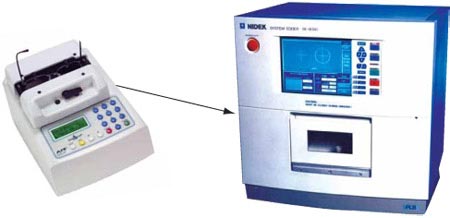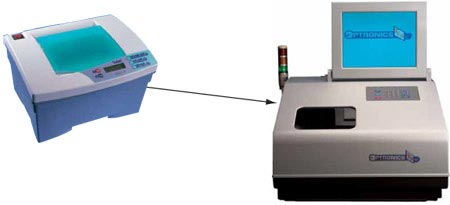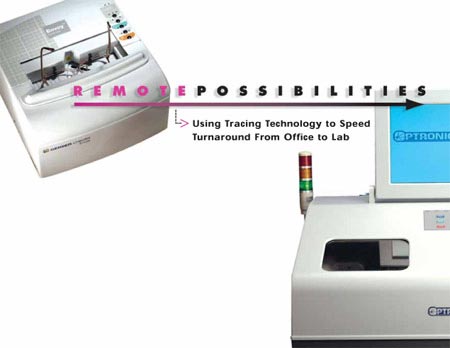|
Speed and convenience are the twin mantras of customer service in our fast paced world. The optical industry is no exception. Along with quality patient care, providing quick service on a new pair of glasses helps to reinforce patient satisfaction and loyalty. It also closes the sale faster to improve your cash flow. So it pays, literally, to turn jobs around quickly.
One way to offer speedy service is to set up an in-house finishing lab. But for practices without edging equipment, the key to fast service is quick turnaround at a commercial lab. What’s the fastest way to get your job orders started at a lab to speed up turnaround? Phone? Fax? Fed Ex or lab courier? They all work, but nothing beats online remote frame tracing and order entry to get your job started within hours, even minutes of completing a patient exam.
With a remote frame tracer, you can transmit precise frame measurements to your lab along with the patient’s Rx and job data by using computer software that communicates via modem or an Internet portal. The lab can start processing the lenses using the trace, so there’s no waiting time for frames to arrive.
THE MOVE TO REMOTE
Remote tracing has progressed along a long and bumpy learning curve over the last 20 years. The early remote frame tracers had poor accuracy rates and were difficult to calibrate. And connecting remotely to a lab could be a complex process often stymied by software incompatibility issues. But all that’s changed.
Two significant trends have emerged in the new millennium to help enhance remote connection possibilities. First is the increased precision of remote tracing equipment that can record and transmit frame measurements with a high degree of accuracy. The second trend is the use of Internet connections and versatile software to facilitate communications between remote tracing locations and destination labs.
The use of remote tracing is on the rise, tracking in tandem with the increased use of online order entry systems. More practices now send spectacle lens orders to their wholesale lab using computer-based ordering systems. This has nurtured a growing comfort level and expertise among optical personnel with using the computer, the Internet and remote technology in general.
According to L&T’s 2006 Lab Usage Survey, almost 33 percent of practices sent frame tracings with their online lab orders in 2006, compared with only 19 percent in 2004.
 SPEEDS UP TURNAROUND SPEEDS UP TURNAROUND
Eye care practices use remote frame tracing to kick-start their lab jobs. “Speed is the key benefit,” says Louise Mon, an optician working with Starer, Rizzo and Ruffini Ophthalmic Associates in Ridley Park, Pa. The practice uses a National Optronics 4T tracer to transmit its jobs to Balester Optical. Walt Komski, production manager for Balester in Wilkes- Barre, Pa. wishes that more accounts would use remote tracing because “it expedites our frames-to-follow jobs.”
The way it works is simple. The retail site needs a frame tracer, a computer and a modem or online connection. A frame tracing is transmitted along with the Rx and job data within minutes of fitting a patient and job orders are sent via computer to the lab throughout the day. The lab can begin cutting the lenses using exact frame measurements without waiting for frame delivery, which eliminates at least one day in the job turnaround time.
Some practices opt to mount the finished lenses themselves, and keep the frames in their offices. Others send the frames after submitting the orders electronically to let their labs complete the jobs. This places final responsibility for mounting the lenses with the labs, a consideration given the risk of spoilage when assembling today’s high-end premium lenses. Frames can be sent for next day delivery using courier or overnight delivery services to complete the job faster.
LENS ONLY JOBS
Processing “lens only” jobs remains one of the biggest benefits of remote tracing. “We work with an ophthalmology practice and we do a lot of ‘one lens only’ jobs for patients after surgery,” says Mary Lou Gasser of the Wooster Eye Center in Wooster, Ohio. “With remote tracing, our patients can keep their glasses until replacement lenses are ready, which is a very valuable service.”
Audrey Mead, practice manager for Mead Optometry in Woodbury, Minn., recalls that her office first investigated remote tracing to get accurate sizing for “lens only” jobs. Today, all of their jobs are sent online with remote tracings. Except for “lens only” jobs, she prefers to have Walman Optical do the frame mounting on all their jobs “so that our staff opticians can spend their time working with patients. This saves staff time and money.”
PREMIUM LENSES, SURFACING JOBS
Getting jobs started sooner via remote tracing is especially beneficial when requesting specialty products like AR coating, which adds an extra day to the process time. Notes Chris Brown, manager of the Walman/Soderberg help desk, “We can get started within 45 minutes of receiving a remote trace and get the lenses out to the AR coating facility faster so the job is ready sooner.”
Edging practices are also using remote tracers, especially for ordering uncuts from their surfacing labs. “By sending a remote trace along with the Rx, we can fabricate a lens for the exact frame geometry instead of a generic shape,” says Brown. “This ensures that the lens is the accurate thickness and has the best cosmetics.”
LINKING MULTI-LOCATION PRACTICES
Remote tracers are ideally suited for eyecare practices with multiple retail offices, which use them to link non-edging locations with a central shared finishing lab. This provides the productivity and cost benefits of in-office edging without having to duplicate lab equipment.
South Jersey Eye Physicians has three locations, each with opticians who fit patients for spectacle jobs. A frame tracer is used at each office to record and send job data via a closed loop system to the company’s central finishing lab in Moorestown, N.J.
“Our remote tracing system reduces downtime and costs,” explains Lou Dinardo, the optical lab technician who runs the company’s central lab. “I print job tickets and order uncut lenses throughout the day for faster turnaround time. A record is kept of all frame and job data with Santinelli’s IntelliTrace system so we can update jobs as needed.”
REMOTE TRACING EQUIPMENT
Unlike the first generation, newer remote tracers provide a high level of accuracy in capturing frame measurements. All tracers measure in 3D, recording frame size, shape and curvature. Some also measure thickness and the frame bevel angle and use multiple frame reference points to record an exact trace.
Remote tracers are now fully automatic and simple to learn and use. Frames are placed into a clamping mechanism, where a stylus automatically records the contours of the eyewire in about a minute. High-wrap frames can be easily traced by placing either right or left eye in an angled manner in the tracer. This accomplishes a mirror trace for both eyes.
Most tracers are compact and easy to fit into a small office space near a computer. The units, priced between $5,200 and $6,000 by the manufacturers, can also be purchased from labs. Before you buy any equipment, talk to your wholesale labs about equipment compatibility and check out any lab purchase- rebate programs. Some labs will discount the jobs submitted on tracers purchased directly from them, which represents a cost savings for you and a loyalty- building strategy for the lab.
“Our tracer has pretty much paid for itself with the rebate we get from Walman’s,” says Debi Ross, assistant manager at Eye Care Eyewear in Tullahoma, Tenn., noting “the payback makes it very efficient.” An investment in remote technology is also offset by reduced dispensary costs for staff time and paperwork processing.
 SOFTWARE CONNECTIONS SOFTWARE CONNECTIONS
At the heart of remote technology is the software, including tracer software and host lab software. Tracer software captures frame measurements along with the Rx, patient and job data and transmits this to a lab’s order entry software via an office computer and modem or an Internet portal. Bar codes and job tracking numbers are assigned and the status of the job can be checked in real time throughout the job process. Among the host lab software systems in use are DVI’s RxWizard, Optifacts Inc.’s Optifacts and OMICS, Gerber- Coburn’s Innovations, C.C. Systems’ Labzilla, VisionStar’s LMS and Optical Online.
ECPs can also connect to labs through an Internet portal such as Vision Web (www.VisionWeb.com), which is designed to facilitate online ordering from multiple labs, vendors and distributors. This service provides interface software to link with a variety of remote tracers, lab order entry systems and practice management software to create compatible communications across technologies and avoid duplication of data entry.
Whether you are purchasing a remote tracer or linking up one you own, a lab sales rep will help set up the equipment and software connections needed to get started. Compatibility is the key issue. Most equipment is VCA compliant so the machines can “communicate” successfully, but your lab is the authority on what will work. For connections between multiple retail locations, check with tracer manufacturers who provide “closed loop” software.
A side benefit to using remote order entry systems is catching errors early. Greg Stone, eBusiness sales manager for Essilor Labs’ Trace and Transmit program, notes “a big problem labs have with paper orders is missing information. Electronic orders avoid this by alerting the ECP’s office when there are order omissions or problems before the order is sent.”
ACCURACY CHECKS
Even though remote tracers are “auto-calibrating” and the software is user friendly, success with remote tracing requires attention to detail. It’s important to confirm that the tracer readings are in synch with the lab’s finishing equipment to ensure accuracy. How often this is done can vary from every day to a few times a month, depending on the equipment, its frequency of use and individual lab protocols.
“We make sure our lab edgers are calibrated to accept the proper left-right sizing,” notes Ted Mabry, production vice president at Interstate Optical in Ohio, which sets up the tracers and software for its customers.
Lou Dinardo does a sizing check every morning to make sure the trace measurements at each of his satellite locations match the readings in his lab “because this procedure is extremely important to avoid incorrect sizing issues.” Bill Inman, senior VP and chief operating officer of the CSC Group in Watsonville, Calif., notes that for remote tracing to work successfully, it’s important “that the ECP’s staff be vigilant about maintaining the equipment and careful about checking the accuracy of the trace.”
Remote tracing isn’t for every practice, but it has many applications that enhance both office and lab productivity and patient service. Those who use it say it is accurate, reliable, easy to use and saves them time and money. The technology allows even smaller practices to stay competitive on service with the big chains. “Remote tracing works best when the person in charge at the retail end has some dispensing experience and optical knowledge,” says Ed Schmidt, branch manager of Soderberg in St. Paul, Minn. Bottom line: Technology is only ever as good as the people who use it.
LT
Remote Tracing Equipment
Delta-Scan 3D, AIT Industries, (800) 729-1959 — AIT’s Delta-Scan 3D tracer provides a fully automatic 3D tracing of the right or left eye or dual eye readings. The unit traces from a frame, pattern or demo lens, and is VCA compliant and bar code compatible.
Santinelli LT-900, Santinelli International, (800) 644-3343 — Santinelli’s LT- 900 3D tracer features computer-ready micro-processing that allows it to interface with most software and edging equipment. Automatic binocular tracing measures both left and right sides of the frame within 0.001 mm measurement for accuracy.
National Optronics 4T, National Optronics, (800) 247-9796 — The 4T tracer from National Optronics traces both eyes in 3D and can handle difficult shapes including hi-wrap frames and small eyewear with accuracy. It is fully interfaceable with most third-party software packages and has an internal memory of over 100 shapes..
Briot Scanform Net 2, Briot USA, (800) 292-7468 — Briot’s Scanform Net 2 features exclusive 5D tracing, measuring frame size, shape and curvature as well as thickness and the frame bevel angle for optimum cosmetic appearance and fit. It traces one.
Gerber Coburn Envoy II, Gerber Coburn, (800) 843-1979 — The Gerber Coburn Envoy II’s three-axis control captures 3,200 reference points including the A and B measurements and the frame curve and elevation for accurate lens fit. Both eyewires are traced sequentially or one eye can be traced separately. The unit requires minimal maintenance.
Topcon FR-20M, Topcon-ODI, (888) 551-2020 — Topcon’s FR-20M is a fully automatic 3D tracer with one-touch loading that secures the frame automatically for easy loading and on-axis tracing. The unit stores frame and job data including lens selections, coatings, tint and other specifications electronically in a computer.
|




 SPEEDS UP TURNAROUND
SPEEDS UP TURNAROUND SOFTWARE CONNECTIONS
SOFTWARE CONNECTIONS







